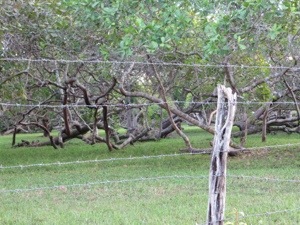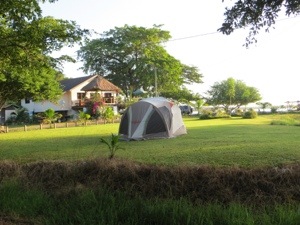Crossing the border from Mexico to Belize was not as complicated as it could have been, except for the part when, due to confusing signage, we tried to go through the military section, and also when, due to no signage, we almost busted through Mexican customs without getting our exit visas (and paying our generous exit tax).
On the Belize side, which we arrived at after an extensive no-mans-land, we were taken to a little hut where we paid several more fees and taxes. The officials (at least, they looked like officials) at customs laughed very hard at us when they learned we had paid these in US dollars, which are worth twice as much as Belizean dollars. We didn’t mind so much having overpaid (it wasn’t much money), but the laughing was annoying, since a) it was their fault for not specifying the currency anywhere on the signage and b) it’s always tacky to tell someone they shouldn’t have done something that it’s too late to do anything about. The customs and immigration shed was a huge, official building, almost completely empty; a customs official (who was either so bored or so tired that he could barely keep his eyes open) stayed awake long enough to interrogate us pretty thoroughly (albeit slowly) about our car and its registration. He finally decided we could pass, mumbling some instruction in a voice so lazy that we couldn’t understand even after three repetitions.
And then we were in Belize! It’s lovely here. The little villages are tidy and welcoming, and the cities are dusty and disorganized and also welcoming. The foliage is gorgeous, and the variety of wildlife is incredible. Everyone we’ve met has been friendly and warm and relaxed.
Our first night was spent in the Crooked Tree wildlife reserve. Its center is a creole village (said to be the oldest inland European settlement in Belize), which is accessible by a bone-rattling dirt road and a causeway across one of the several lagoons in the area. The preserve is huge, encompassing swamps, forests, savannahs, lagoons, and creeks, and is home to bazillions of species of birds; it is one of the most important wetlands in the world.
The crooked tree itself is a cashew tree; the area is full of cashew plantations. Very sadly, it was not cashew season.

We stayed at a lovely place called the Crooked Tree Lodge, where we opted for the most comfortable camping so far.

We woke up at dawn to watch the avian activity. Had we been actual birders, we would have been in hog heaven; birds of all description were everywhere. Despite being armed with binoculars and two different field guides, we were completely unable to identify a single bird. The birds in the field seem to have mutated somehow from the ones in the books. I saw a beautiful little hummingbird with a green neck and red tail; there are three pages of hummingbirds in the book, but not one that looks like that. I saw a water bird with a yellow mask and yellow legs; there were water bird with yellow masks and black legs, and black masks and yellow legs, but not both.
Onward.


I tried to take pictures of the birds but I couldn’t handle binoculars, field guide, AND the camera. I did get a couple of shots of the toucan in the zoo, though.
Border crossing is always terrifying to me despite the fact that the only one I cross with any regularity is the US – Canada crossing. Cool about the birds. Wonder if they’re local hybrids like those interesting Canada Goose x White Goose birds that hang at Gallup?
Onward really? I’d stay there a few days, I think. The description of border crossings reminds me of my Soviet Union days. Did you get any photos of the unidentified birds? I’m so envious – not that I’m a birder, but that must have been amazing (especially if the Sikkenga-Velick family actually got up at the crack of dawn). 😉